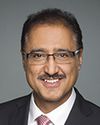Thank you for that question.
Through you, Madam Chair, as you may recall, part of the mandate letter from the Prime Minister aims to refocus the existing building Canada fund toward more trade-oriented infrastructure. In consultation with my colleague Minister Garneau, we are looking at how we can align some of the infrastructure funding that is available to us toward the outcome of the Canada Transportation Act review that is under way. Minister Garneau will be able to fill you in on the details of the review, at what stage it is, and how much time it will take.
You're absolutely right. In order to grow the economy, we need to make sure we have efficient transportation corridors to move our goods and services. We will enhance our international trade with the work we're doing on the Gordie Howe bridge and the new Champlain Bridge, as well as support additional investments in the trade corridors. These are some of the requirements. The expectation of the Prime Minister is that my department work with Minister Garneau's department, and we're doing that.






